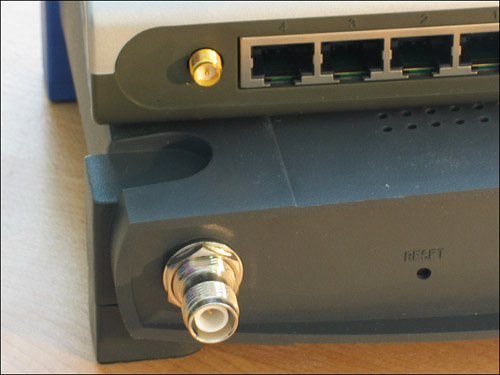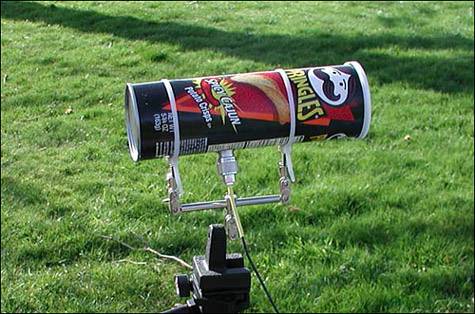Adding an Antenna to an Access Point
| As they say, some guys have all the luck. If your access point does not have a connection for an external antenna, you can't add an external antenna to it. (And you are out of luck!) On the other hand, if your access point, such as the Apple Extreme Base Station, comes with a connector for an external antenna, it is usually a simple matter to plug an antenna in. (And, you've got all the luck!) Other access point units fall somewhere in between. For example, the D-Link AirPlus Xtreme Wireless Router that I've discussed earlier in this book, comes with a single, rather small antenna (see Figure 16.5). Figure 16.5. The D-Link unit comes with a single, small antenna.
This antenna can be unscrewed, as shown in Figure 16.6, and a more substantial external antenna used in its place. Figure 16.6. The D-Link's original antenna can easily be unscrewed in order to replace it with a more powerful external antenna.
Adding an external omnidirectional antenna to an access point is essentially a no-brainer. It installs in a jiffy, will improve the range of your access point, and there are no trade-offs. (You don't lose anything except your out-of-pocket cost to buy the antenna.) Note Although some Wi-Fi access points intended for home use don't have an external antenna connection, many do. So if you want to have the benefit of extended range from better antennas, shop carefully to find an access point where the antenna is removable. Original antennas on access points are pretty small and generally deliver only 2dBi gain at best. Figure 16.7 shows the difference between the original antenna on a D-Link DI-624 and an omnidirectional "rubber duck" antenna with 5.5dBi gain. This larger antenna was purchased mail order from Sharper Concepts for $9.95 plus shipping. Figure 16.7. The original antenna on a D-Link Wireless Router compared to a larger 5.5dBi antenna.
To purchase an antenna that will fit your equipment, you need to know the correct type of antenna connector. Access points with removable antennas almost always have one of the following connectors:
Figure 16.8 shows an example of each connector. If you have difficulty determining which type your equipment uses, consult the website of the access point manufacturer for technical specifications or contact their technical support. HyperLink Technologies has a fairly complete access point-to-antenna connector cross reference list on its website. See http://www.hyperlinktech.com/web/radio_to_connector_list.php. Figure 16.8. Examples of an RP-SMA connector (top) and an RP-TNC connector (bottom).
The most gain you will achieve with an antenna directly connected to the access point is about 5dBi6dBi, as you saw with the rubber duck antenna earlier. To get more gain or to use antennas with special radiation patterns you need a "coaxial pigtail" to convert from the connector on the access point to a more standard antenna connector called Type-N. Figure 16.9 shows a D-Link Wireless Router, an RP-SMA to Type-N pigtail, and an 8dBi omnidirectional antenna suitable for indoor or outdoor use. Figure 16.9. The D-Link Wireless Router is shown with the black pigtail connector and white omnidirectional antenna.
Access points and wireless routers are generally not intended for mounting outdoors. That means if you want to put an antenna outside your house, you will need an antenna feed cable to go from the access point inside to the antenna located outside. You need to be sure you get the right cable for the job. There are special types of low-loss coaxial cable for use in 2.4Ghz applications. Suppliers of antennas and antenna pigtails also sell premade cable assemblies with Type-N connectors just for this use. Before purchasing cable, be sure it is specifically intended for use with Wi-Fi equipment. Using the wrong antenna feed cable can result in a significant loss in signal strength, defeating the purpose of special antennas. Using a coaxial pigtail to convert to the Type-N connector opens the door to a large variety of antennas with special radiation patterns. Selection of more complex, directional antennas is a trickier story than the omnidirectional antennas we have looked at so far. If you are thinking of fitting your access point out with a directional antenna, you need to think carefully about how radio signals will propagate given the terrain you need to cover. What the Antenna Should CostAs you can imagine, there's a great range in price for antennas designed to work with access points. Rubber duckstyle omnidirectional indoor antennas are very inexpensive and deliver great value. They can be had for less than $20 from many online suppliers. Omnidirectional antennas intended for outdoor use start at about $50 and can run you $200 and up. Directional antennas intended for external use run a little more than omnidirectional antennas. Highly specialized directional antennas can be very expensive indeed. If you are interested in the multipolarized antennas mentioned earlier in this chapter, you can probably expect to pay a bit more for this feature. A omnidirectional multipolarized antenna intended for external use runs about $150. Directional multipolarized antennas, often used for point-to-point back haul traffic, cost between $200 and $900. Of course, like everything else related to technology, many antennas can be found for sale on eBay. If you've read this chapter, and understand Wi-Fi antennas, you should be able to buy one safely on eBay and save some cash. The Antenna in a CanIf springing for a commercial antenna is too expensive for you, you can always consider building a "Cantenna." The total cost of a Cantenna, which uses an old can as its primary part, is less than $5. There's a whole subculture that has formed around building Wi-Fi antennas from cans. Raw materials have ranged from Pringles containers (see Figure 16.10) to (the rather more successful) tin can models. There's even a company, Cantenna, that now sells commercial antennas made from cans. Figure 16.10. This Cantenna made from a Pringles container is a directional yagi-type Wi-Fi antenna based on a design by Andrew Clap.
Besides the tin can, which should be between three and four inches in diameter, the only things you need to build the Cantenna are
The Type-N connector is the standard connector for antennas and will be used to connect it to your Wi-Fi equipment. The cost for this connector is $35, which is where I got the original figure of less than $5. You can buy this connector from any of the sources I mentioned as selling radio pigtails (or go to your local Frye's or electronic hobby store such as Radio Shack). Note As I noted earlier (see "Antennas and the FCC" earlier in this chapter), homemade antennas are probably not compliant with FCC regulations. You drill holes in the can for the connector and for the nuts and bolts. Their placement is important because it determines the propagation characteristics of the antenna. The copper wire is attached to the back of the connector and soldered to the tin can. The best how-to article I've seen that describes creating a Cantenna, "How to Build a Tin Can Waveguide Antenna," is by Gregory Rehm and can be found at http://www.turnpoint.net/wireless/cantennahowto.html. The article includes a calculator to help you determine where to place the connector and nuts and bolts. You can also purchase a premade Cantenna for $20 (this one meets FCC regulations) from Super Cantenna at http://www.cantenna.com. (They sell pigtail connectors besides the Cantennas.) |
EAN: N/A
Pages: 204





